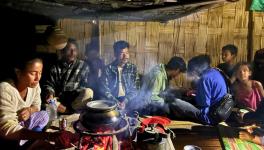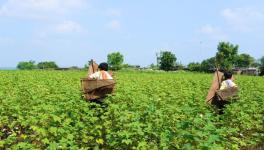Adverse Weather Hits Himachal Apple Crop, Growers Demand Govt Support
Damaged apple in Puran Thakur’s orchard
Over 1.7 lakh families in Himachal Pradesh cultivate apple, a high-value fruit that fetches good prices in the retail market. Roughly one-third of India’s total apple produce comes from here, valued at Rs 4,000- Rs 6,000 crores and accounting for 6% of the hill state’s GDP. So when a long spell of a heatwave in April, followed by insufficient rainfall in June hit apple orchards, the prevalent mood among growers dampened.
“Fruit quality has certainly suffered due to the drought. The damage is considerable in orchards situated at lower heights up to 6,500 feet. Cracks and black dots have appeared on the apples. Even in higher ranges, these symptoms have emerged to some extent,” said Susheel Chauhan (52), an orchardist based in tehsil Kotkhai of Shimla district. Chauhan has various small-sized orchards, scattered over 5,500 feet right up to 7,500 feet.
Another grower confirmed Chauhan’s observations from the Kullu district. “The size of apples is small and they appear deformed; such apples have suffered from premature dropping. There is discolouration as well,” Puran Thakur (44) who looks after 300 apple trees, told NewsClick.
When asked about the estimated impact on the production of good-quality, ‘A- Grade’ apples, both of them expected their proportion to the total produce to fall from the usual 60-70% to 50-60%. At the same time, they also expect the proportion of ‘B-grade’ apples to rise to almost a quarter of the final output.
‘A- Grade’ apples go for anything between Rs 60- 150 per kg, depending on whether the market is suffering from a supply glut or not. Poorer quality apples, such as the ‘B-grade’ and culled fruit are sold at throwaway prices in mandis, or are procured by state agencies like Himachal Pradesh Horticulture Produce Marketing and Processing Corporation (HPMC) or Himachal Pradesh State Cooperative Marketing and Consumers Federation Ltd. (HIMFED) at a token rate of Rs 8 per kg. Evidently, it is essential for the orchardists they produce a healthy crop, or else, the entire year’s effort could lead to losses.
For instance, on a good year, Chauhan can make up to Rs 3 lakh in net income. But in the past, when the weather turned hostile, he had to suffer losses. The prevailing conditions are such that a similar tragedy can strike him again this year.
‘WARMING OF INDIAN HIMALAYAS HURTING APPLE CROP’
In a recently concluded workshop of apple growers organised by the All India Kisan Sabha (AIKS) in Srinagar, many of the present conditions were identified as symptoms of climate change in the Indian Himalayas. Om Prakash Bhuraita, director at the State Resource Centre, Shimla, and one of the speakers at the workshop, explained how the apple fruit was particularly sensitive to temperature variations in different stages of its growth.
“Adverse climatic factors are resulting in reduced apple productivity. The rise in temperature and moisture stress is leading to more incidences of sunburn and cracking in apples, affecting their quality. The high (>26°C) or low temperature (≤15°C) during the flowering phase reduces the apple crop,” he noted.
Apples have developed cracks, show spotting, and are unshapely this season.Image Courtesy: Puran Thakur
In March and April, when the apple tree is in its flowering stage, the temperature in Himachal Pradesh was four degrees higher than what is considered normal, according to a CSE report. “This is almost twice as much as the anomaly observed at all India level, and it holds true for even average daily minimum, daily mean and land surface temperatures,” it added.
POOR RAIN AND HAILSTORMS ADD TO THE WOES
The effect of rising temperatures has been exacerbated by a delayed monsoon. According to the data from the Meteorological department in Shimla, rainfall deficiency hovered at high levels, touching 95% in March, and improving negligibly to 89% in April. Even in June, when monsoons are most expected, the rainfalls have remained deficient by 34%. In Kinnaur, which produces the bulk of Himachal’s good quality apples, the deficiency was still as high as 67%.
A poor rainfall doesn’t bode well for the traditional apple varieties grown predominantly in the state. According to Chauhan, whose entire orchard of 500 trees consists of traditional trees (like Red Delicious), their irrigation is heavily dependent on the monsoon since the water required for irrigation is scarce in the hilly terrain. “Only in the lower valleys, where the nalas are present, irrigation is possible, and that too for certain varieties like the Dwarf variety only,” he adds.
Apart from an absent monsoon, hailstorms- albeit in scattered locations, have also damaged the growing crop. In some places, growers endowed with some capital have equipped their orchards with hail nets. But in most places, netting is not prevalent as the governmental subsidy on it has long disappeared and growers remain at the mercy of nature. Even the insurance scheme appears bogus to them.
According to Puran Thakur, the Restructured-Weather Based Crop Insurance Scheme (R-WBCIS) uses weather monitoring units that are unable to accurately identify the degree of damage done to orchards, thereby negatively impacting the amount of premium accessed by growers. “These (weather monitoring) systems need to be installed in a radius of 1 km, but what we find is that they are installed in a radius of 10 km. Many times, it so happens that there is a hailstorm in a patch of land, say 500 metres in length, and across it the skies are clear. Similarly, due to the hilly terrain, sometimes rains fall on only 300 metres of land, the rest remaining dry. These systems are unable to capture these variations in weather,” he says.
Moreover, Bhuraita observed in the workshop that took place in April this year: “If the weather stations are managed and controlled by the favoured insurance companies, then there is every chance that they will tamper with or manipulate the (monitoring systems) and alter the readings of adverse weather conditions to suit their convenience to avoid any liability.” He added that instead of compensating the losses of growers due to adverse weather incidences, these “Schemes benefit only the banks and insurance companies.”
DEMANDS OF SEB UTPADAK SANGH
Already some reports indicate a reduction in apple production here by 25%. With the harvesting of early varieties beginning from July 10 in the lower hills, more clarity on the extent of losses will emerge. The government needs to urgently respond to what might become a crisis for apple farmers this season.
Both Chauhan and Thakur are members of the Seb Utpadak Sangh, formed recently intending to organise apple growers to build producer cooperatives to enhance income and to place collective demands before the State government. Their foremost demand currently is rightful compensation to orchardists because of the crop losses. Further, the subsidies on hail nets need to be revived, and the cold-storage infrastructure that was built for horticulturists by the government but eventually handed over to private firms, needs to be freed from the latter’s control, they say.
The latter point is essential as growers, with a lower quantum of produce, will prefer to store their produce in cold stores and sell it off after the marketing season concludes and apple prices begin to climb again.
In light of these demands, the Sangh has appealed to apple farmers to join demonstrations on July 11, 2022, at administrative offices in Rohru, Theog, and other places. Apart from the demands related to compensation due to adverse weather, they will also be pressing for lowering the costs of production through state support.
Get the latest reports & analysis with people's perspective on Protests, movements & deep analytical videos, discussions of the current affairs in your Telegram app. Subscribe to NewsClick's Telegram channel & get Real-Time updates on stories, as they get published on our website.
























